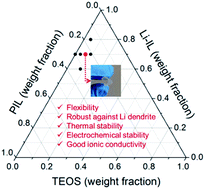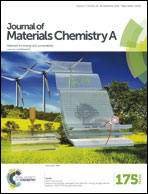High-performance polymeric ionic liquid–silica hybrid ionogel electrolytes for lithium metal batteries†
Abstract
In this work, a new class of high-performance polymeric ionic liquid–silica hybrid ionogel electrolytes (HIGEs) is developed by a nonaqueous sol–gel route, in which LiTFSI–ionic liquid as the ion conducting phase is immobilized with a hybrid pyrrolidinium-based polymeric ionic liquid and silica matrix. The thermal and electrochemical properties of these HIGEs as well as their application in lithium metal batteries (LMBs) are investigated. It is found that HIGEs reveal excellent thermal stability, good room temperature ionic conductivity, high electrochemical stability, a suitable lithium ion transference number, and potential to suppress Li dendrite formation. In particular, Li/LiFePO4 cells with the as-obtained HIGE at 0.2C rate can deliver a discharge capacity of about 150 mA h g−1 at 25 °C, with excellent capacity retention. Moreover, at 0.5C, 1.0C, and 2.0C, the stable discharge capacities are as high as 138.1 mA h g−1, 120.3 mA h g−1 and 73.8 mA h g−1, respectively. The desirable battery performance can be attributed to the good electrochemical properties of HIGEs and interfacial compatibility between HIGEs and electrodes. These findings show that HIGEs prepared in this work have great potential for application as safe electrolytes in LMBs.


 Please wait while we load your content...
Please wait while we load your content...